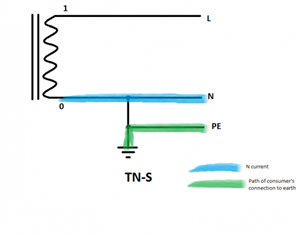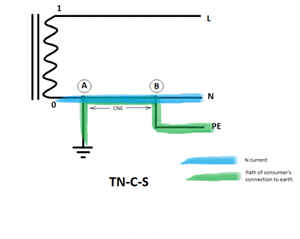The BS7671 definition of PEN is simply about sharing protective and neutral conductor functions; and the definition of protective conductor functions includes connecting an earth electrode to a source neutral point.

Thus what Andy has drawn would be TN-C-S if the exposed parts in the installation are connected to a separate protective conductor. Any PNB system would also be described as TN-C-S in Ireland.

AJJewsbury:
In my copy of BS 7671 it seems to be worded slightly differently - mentioning only "The earthed point of the source, or an artificial neutral". Thus the neutral (star point) of the source could be distinct from the earthed point of the source.
it doesn't matter how long the conductor between the star point ("0") and the N-PE link is - it's still just a neutral conductor.
Personally I prefer to think of protective conductors in term of the path of the consumer's connection to Earth - rather than the Earth Fault Loop - as the latter includes the conductors back to the star point - which seems to cause more than its fair share of confusion.
AJJewsbury:
Thus what Andy has drawn would be TN-C-S if the exposed parts in the installation are connected to a separate protective conductor. Any PNB system would also be described as TN-C-S in Ireland.
I'm not sure that's right. TN-S vs TN-C-S and PNB vs PME are almost two different things. TN-S vs TN-C-S is about whether there's a shared neutral and earth conductor at some point in the system; PNB/PME is down to how many distinct connections to earth the N has (one vs two more).
PNB could be either TN-S or TN-C-S depending on whether the N-PE link is upstream or downstream of the earthing of the N.
The above would be the TN-C-S version of PNB, but add an extra electrode between A and B and it becomes PME. But the earlier diagram would be TN-S in Ireland as well I think - there being no CNE.
- Andy.
We're about to take you to the IET registration website. Don't worry though, you'll be sent straight back to the community after completing the registration.
Continue to the IET registration site